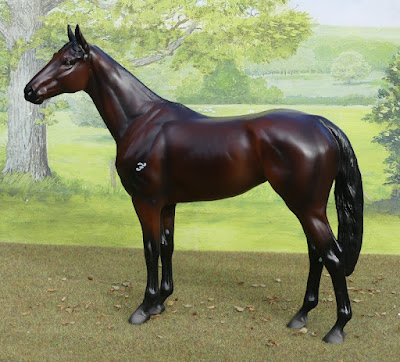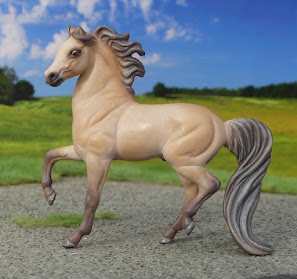Breyer once released this Connemara mould at the original larger scale as a Sable Island Pony, and because of the pose, I much prefer it as a feral breed type than a polite domesticated pony (my own horse's portrait being the notable exception, as she's playful and rough rather well-mannered and placid). So I decided to do at least one of my mini versions as a Sable Island, too.
I spent some time looking through colours, and while many are the same shades of bay and chestnut that you'd see on any other kind of pony, there's some more unusual colours, too - often sun-faded and sea-bleached from their outdoor all-weathers island lifestyle. In the end, I decided to go for a shade I've never tried painting before, and based my paintwork on the horse on the right in
this photo.
The hardest part was getting the blonde mane to go over the top of the dark shading, I don't think I've quite got the softness and blending of colour I was aiming for, but it was too difficult getting the colour right with my limited palette (and my blondest-looking paint dried up in the pot, so I was making it from white, yellow, and beige), and I kind of gave up when it looked decent even though it's not very neat or smooth. A bit more like impressionist oil painting than I usually like to leave it!
I've named her Estrella - I chose
my first Sable Island Pony's name from a list of ships wrecked there in the 17-19th centuries, as that's how it's believed horses came to be living on the island in the first place. So I went back to the list and chose another which made a likely sounding name for a pony as well as a ship.
Now, something much more familiar and local to me, a couple of traditional cobs!
I looked at what I'd painted already, one piebald and one bay skewbald (or black tobiano pinto and bay tobiano pinto, to use the international terms) with about the same ratio of white to colour on each, and decided the next logical variation I should go for a different base colour, combined with less white and more patch.
I really like how his markings turned out, I painted them over the seal brown base coat rather than base-coating white then trying to paint carefully within the patches, which made it a bit easier - this works best when there's going to be more colour left showing, but is the frustrating way round when you've got a lot of white to colour cos it's hard to get it perfectly smooth if you're covering a lot of surface.
He looks like the sort of horse you'd enjoy seeing frolic out in the field, but wouldn't especially want to have to lead anywhere!
By the way, you can click any photo on this blog to see them full size - especially worth it when I've arranged them as side-by-side small versions for formatting reasons!
I've called him Harecroft Helter-Skelter. My large scale one in this same mould is Hurly Burly, so it's kind of carrying on a theme!
Rather than go straight for another variation of a tobiano, I thought I'd try something really different with the next one - a blagdon cob. The splashed, freckled, and roaned sabino horses are known as blagdons in the cob/traveller community, an older name for them which hasn't been changed now there's been all the research and understanding of equine colour genetics. So this custom is a sabino
or a blagdon, depending on which tradition you want to go with - here's
a real example just so you can see the kind of colour I was aiming for!
I set about his colour in a different way than I'd usually paint, just cos it's so hard to figure out how to get the mottled colour effect. First the body had a total coat of white, several layers very thin so it would be as smooth as possible. Then, I scribbled all over him with a pencil!
I hoped getting the hairy, roany colour laid down with scribble first would give the finished thing more texture, so it doesn't have to be as painty-looking. Over the top of the scribble was another layer of thin white paint, to help blend it in but also to seal it, so it wouldn't rub off or smudge while I carried on handling him. Then the pinking for where the skin shows through the coat, and some diluted grey added over the top of the colour patches with a fine brush, so they're emphasised and blended in without being too dark or too heavy.
I gave him two blue eyes, cos white markings which catch an eye socket often have that effect on real horses. His name is Harecroft Jack-the-Lad, because I happened to be watching a history documentary which explained the origin of that phrase!
The colour does look quite good on the mould, so far I've only done the more typical tobianos with large solid patches of colour, and I don't generally do many pale colours on any kind of mould, so it's been interesting for me to try this (I've been pushing myself for more variety lately, so you probably have seen light coats from me on here, but over all the years I've been painting, I know I have a big bias to darker colours and dark pintos)
I have two more of the cob mould left from the lucky dip parcel; I'm thinking a buckskin or golden dun tobiano would look nice - another with more colour and less white.
Next, I made an attempt at a really dark sooty buckskin, which ended up looking FAR more like a bay than I wanted!
At a glance you'd just think I was aiming for dappled bay, which is disappointing cos I've done that colour loads of times before, and really thought I'd avoid it coming out too similar cos I used different paint colours in the mixing here. But no, just another bay-ish horse after all!
It's a nice enough result, the colours blended together okay, so it's no disaster - I like her, and have named her Basilisk. It's just incredibly frustrating that I can't figure out a way to keep the light areas more golden in tone, when using any combination of my cream/gold/tan paints with brown and black to darken them somehow always ends up making either a
mess, or yet more warm, reddish shades!
This is a real sooty buckskin, even with trying to
find the closest match to the bright one I painted you can see his light areas are more orangey-golden.
So I decided to take a deep breath, pick another body from the box, and get well away from the sooty/dark kind of buckskin and just paint one I thought I could manage, with no darker browns getting involved in the body colour at all!
Meet Harecroft Diamond Hill - named after a mountain in the Connemara national park - she's an example of the famous Connemara 'dun'. Yes, they're traditionally known as duns, despite being a completely different colour genetically!
A moment to explain...
Dun is a dilution gene, which acts on whatever basic colour the horse carries, and gives them a dorsal stripe, dark points, leg barring, often a dark face, and sometimes pale-haired 'frosting' on the top of the tail and outside edges of the mane. Think of a Norwegian Fjord horse - you just pictured a dun.
Cream is different dilution gene, it lightens colours. Inheriting one gene creates a halfway effect, inherit a gene from both parents and the colour goes even lighter, with pink skin and pale eyes.
If your horse's basic colour is bay, inheriting one cream gene turns the brown/reddish/mahogany-coloured body to a lighter gingery/tan/gold shade, while the points stay black.
Centuries ago, the British & Irish horse breeders, owners, and riders didn't know all this. They called any horse with a sandy body and dark points a dun, and ingrained traditional words are really, really hard to get rid of in the horse world. Even these days, with the majority understanding horse colour a lot better thanks to online information and genetic testing, within certain breeds there's an outright refusal to change terms used. So buckskin Connemaras, and Welsh ponies/cobs, are often stubbornly described, and officially registered, as dun - even though there's no actual dun genes in the breed.
Despite all the potential confusion about colour, I wanted to paint the lovely bright clear buckskin, which is a very popular and famous colour for this breed to be - the 'duns' are often favoured over other colours for sales prices and for show ring honours, and almost all the horse books will make a point of mentioning them, though they rarely point out that dun's not dun in this case!
So ever since this mould came out, I'd thought that this would be the perfect colour to paint it, and it seemed timely, too - helping even out my previous failed attempt by getting a buckskin right this time!
While I was looking through reference pictures for a standard pale buckskin, I happened across a couple of photos I'd bookmarked a while back -
silver buckskins.
Here's one of them (sorry for the horrible way of linking Google has come up with lately, there's no other way of doing it without stealing the photo and uploading it myself, and I wouldn't do that!)
Silver is yet another gene which can alter basic horse colours. On a bay horse, it turns the mane and tail silvery and the lower legs brown, instead of black. Now add cream as well, and you've got a pale sandy body colour, brown points, and blonde/silver streaky mane and tail. There's a challenge I couldn't resist!
I think he turned out really well! As long as I'm not trying to add darker shading into the body colour, these cream and beige paints work nicely together, so I can add in highlights and even some dapples to give it a bit more depth.
Morgans are great for painting unusual colour combinations, as there's so many different genes carried within the breed.
I've already painted a silver bay on this mould, and named him Harecroft Silver Dollar, so this one is Harecroft Silver Buck - it works as a themed money pun, a buck as in a stag, and would shorten to just Buck as a nice nickname if he was a real horse!
Here he is with the normal buckskin - you can see the difference is mainly in the lightened points, but I also added more yellow to the mix for the Connemara, and a hint more peach and grey for the Morgan.
That's all for now, but there's plenty more in my body box!






























































